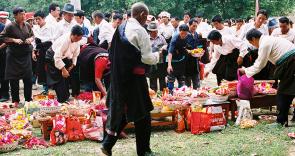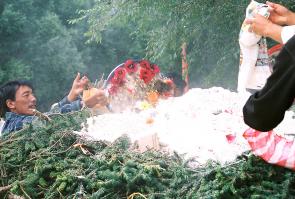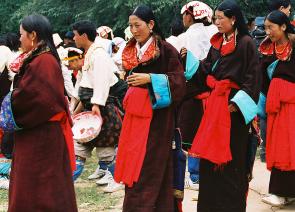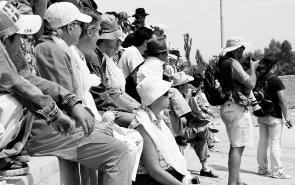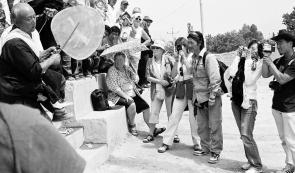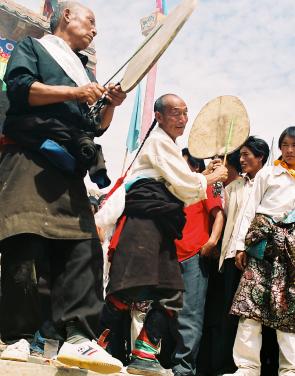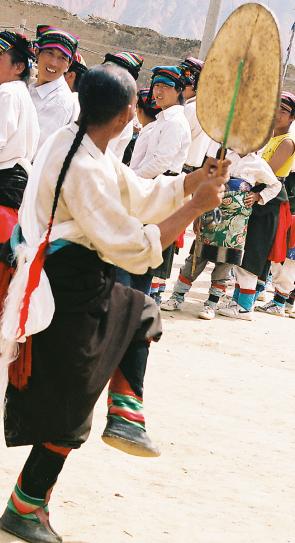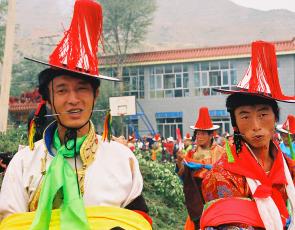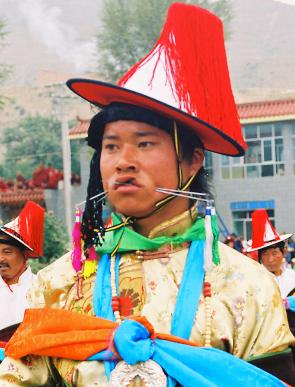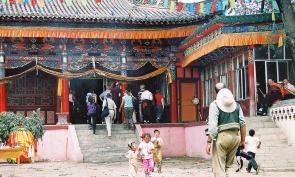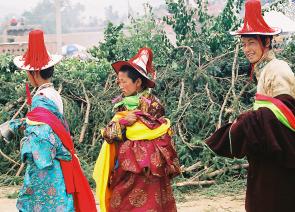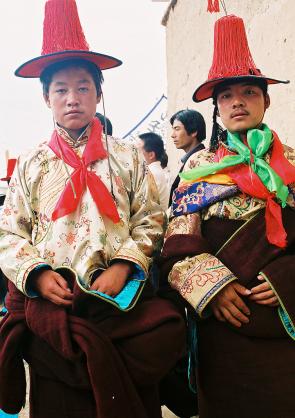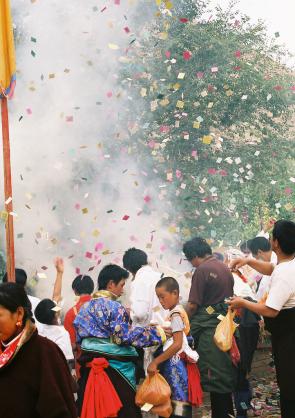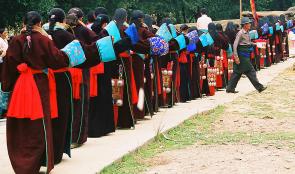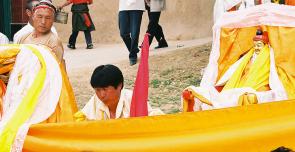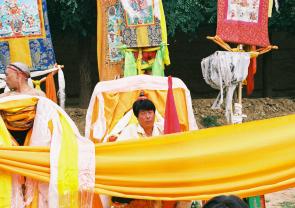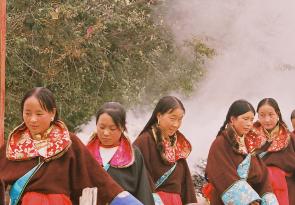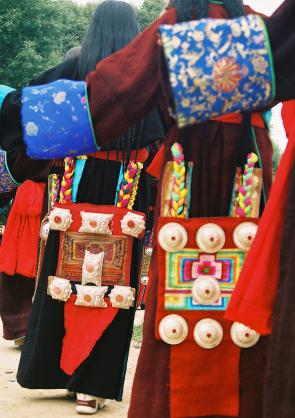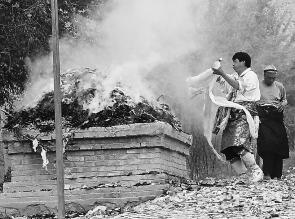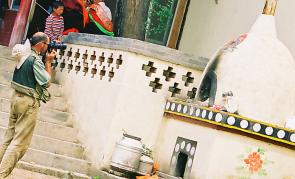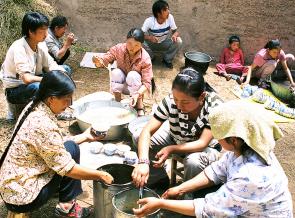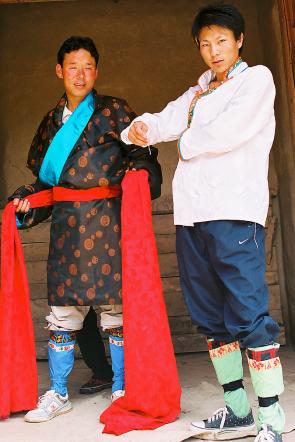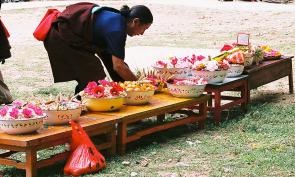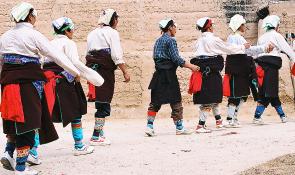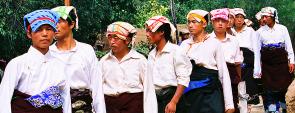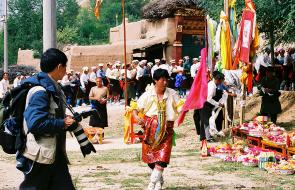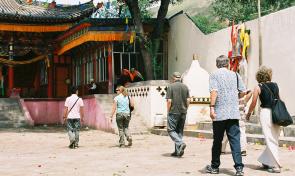In this
chapter Stevenson sketches a history of art in Reb gong since it first gained
national attention. Major themes in the article are the Chinese
interest in China’s ethnic minorities, and the relationship between Tibetan
artists and federal policies on art. He mentions that while “Regong Art” is
extremely popular among Chinese collectors, it is difficult to define,
including at the very least thang ka (including painted, embroidered and
appliqué varieties), statues and ornamental panels (199 ).
In order to
give a background to his study of contemporary art in Reb gong, he then
summarizes what different sources say about the earliest history of the artistic
tradition in Reb gong. To discuss this, he draws on oral tradition and the Mdo
smad chos byung , and then presents the research of Shen
Xueyan , which includes Shen’s chronology and model of art
in Reb gong. Following this, he writes at length (still citing Shen )
about the “Golden Age” of Reb gong art, from the nineteenth to mid twentieth
centuries. In particular, he focuses on the artists: they often began as
teenage novice monks in Reb gong’s monasteries, and often chose between
receiving full ordination or leaving the monastery to become a professional
artist (203-204 ).
Stevenson
then presents a section on Reb gong art after, composed of short
biographies of several local artists and detailing the ways that they were
influenced by the events of the mid twentieth century. Following this is a
section on how the artistic community has changed since, in terms of both
the artists’ lives and the themes of the art. This includes a discussion of the
themes of art and an examination of the “New Painting” movement and the “Great
Thangka”, focusing on political themes (213-214 ).
In general,
this chapter begins with a historical sketch but deals mostly with the interpretation
of art and artists in Reb gong and Dkar mdzes. Bibliographic
references for earlier art history in Reb gong focus on Shen’s works and oral
traditions.
Place Reference:
At the beginning of the ritual, each household brings offerings to the village courtyard where the ritual starts and proceeds from. Tsampa (roasted barley flour), fruits (grapes and apples), breads (all homemade), liquor (barley or rice) and cookies are offered. There are flowers among the offerings as decorations.
When the offering has proceeded to its half-way point, the ritual participants come to the altar with Glung rta (wind horses) and wine to make offerings. After they have made their offerings, they go back to their line and continue circumambulating the courtyard.
While the Lha ba (trance medium) speaks to the male participants, the young village women circumambulate in a slow, systematic step wearing heavy decorations and Tibetan robes.
I was surprised to see so many foreigners during the Klu rol ritual. I was told that some of them are temporary travelers, and that some had lived there for years. During the ritual process, photographers wandered around everywhere without a hint of concern about possibly inconveniencing the participants or villagers. Their cameras kept clicking and no one asked permission.
I was surprised to see so many foreigners during the ritual. I was told that some of them are temporary travelers, and that some had lived there for years. During the ritual process, photographers wandered around everywhere without a hint of worry about possibly inconveniencing the participants or villagers. Their cameras kept clicking and no one asked permission.
Two old men dance with their drums.
An old man dances with his drum in the Klu rol ritual.
All new participants in the Klu rol ritual have to have their cheeks pierced.
All new participants in the Klu rol ritual have to have their cheeks pierced.
I was surprised to see so many foreigners during the ritual.
All new male participants in the Klu rol ritual have to have their cheeks pierced.
I was surprised to see so many foreigners during the ritual. I was told that some of them are temporary travelers, and that some had lived there for years. During the ritual process, photographers wandered around everywhere without a hint of worry about possibly inconveniencing the participants or villagers. Their cameras kept clicking and no one asked permission.
The two boys in these photos are new participants in the ritual. They have to have their cheeks despite their young age. It looks painful but the participants display little sign of discomfort.
When the offering has proceeded to its half-way point, the ritual participants come to the altar with glung rta (wind horses) and liquor to make offerings. After they have made their offerings, they go back to their line and continue circumambulating the courtyard.
While the Lha ba speaks to the male participants, the young village women circumambulate in a slow, systematic step wearing heavy decorations and Tibetan robes.
After the offering is completed, the participants come close to the Lha ba (trance medium), who sits in front of an image which is covered by offered Kha btags (strips of white cloth). He speaks to the participants in a poetic way. I was told that the Lha ba in these images has never been to school and is unable to read or write. There are terrifying stories about the Lha ba. When he is possessed by the local mountain god, he recites what has happened in the previous year and the sins that villagers have committed.
After the offering is completed, the participants come close to the Lha ba (trance medium), who sits in front of an image which is covered by offered Kha btags (strips of white cloth). He speaks to the participants in a poetic way. I was told that the Lha ba in these images has never been to school and is unable to read or write. There are terrifying stories about the Lha ba. When he is possessed by the local mountain god, he recites what has happened in the previous year and the sins that villagers have committed. Often he is able to name specific people and pinpoints what their sin is.
While the Lha ba speaks to the male participants, the young village women circumambulate in a slow, systematic step wearing heavy decorations and Tibetan robes.
While the Lha ba speaks to the male participants, the young village women circumambulate in a slow, systematic step wearing heavy decorations and Tibetan robes.
The Lha ba (trance medium) makes his offerings just after ritual participants have finished their offerings. He was speaking during the offering process but I didn't hear what was said.
I was surprised to see so many
foreigners during the ritual. I was told that some of them are temporary
travelers, and that some had lived there for years. During the ritual process,
photographers wander around everywhere without a hint of concern about possibly inconveniencing
the participants or villagers. Their cameras kept clicking and no one asked
permission.
I was surprised to see so many foreigners during the ritual. I was told that some of them are temporary travelers, and that some had lived there for years. During the ritual process, photographers wander around everywhere without a hint of concern about possibly inconveniencing the participants or villagers. Their cameras kept clicking and no one asked permission.
Five households in the village invite all the villagers to share a meal which is prepared particularly for this ritual. The feast is served before the ritual begins. Because between fifty to seventy people come to eat, all the village women come to help prepare, bringing bowls and cooking tools with them. Big pots of soup with noodles and meat are served.
After the meal the village men go back to their homes to get ready for the ritual. All ritual participants are required to wear a Tibetan robe and Tibetan long-sleeved shirts. These clothes were traditionally everyday wear, but people don’t wear them very often nowadays. The socks that they wear for the ritual are special in that they are homemade and are very different from the ones people wear in daily life.
At the beginning of the Klu rol ritual each household brings offerings to the village courtyard where the ritual starts and proceeds from. Tsampa (roasted barley flour), fruits (grapes and apples), breads (all homemade), liquor (barley or rice) and cookies are offered. Flowers are placed among the offerings as decoration.
The ritual begins with men circumambulating the courtyard. They walk in a systematical gait as a man beats a drum. This constant beat provides the rhythm to keep their steps together. While the men walk, the Lhaba (trance medium) prepares. The entire village attends this part of the ritual. Women with their children sit nearby and watch.
The ritual begins with men circumambulating the courtyard.
During the ritual process,
photographers wander around everywhere without a hint of concern about possibly inconveniencing
the participants or villagers. Their cameras kept clicking and no one asked
permission.
I was surprised to see so many
foreigners during the ritual. I was told that some of them are temporary
travelers, and that some had lived there for years. During the ritual process,
photographers wander around everywhere without a hint of concern about possibly inconveniencing
the participants or villagers. Their cameras kept clicking and no one asked
permission.
Thar has a
large amount of information on Reb gong generally (rather than in reference to
a specific Bonpo sites) in his article “Bonpo Tantrics in Kokonor Area.” In
particular, he gives a detailed breakdown of the general kinds of rituals
performed annually by the Bonpo gsas khang in the Reb gong (Tongren)
County area, including the names of different rituals, their general length,
number of participants, date, a brief description and general importance
(543-544 ).
In this
chapter Costello focuses on the economics behind recent changes in Tibetan-language
education and cultural products (such as newspapers, books, operas, etc.) in
the Reb gong area. The majority of her information comes from her fieldwork in
Reb gong, including both interviews and surveys. She only cites one source, the
Qinghai Tongji Nianjian from 1998 .
